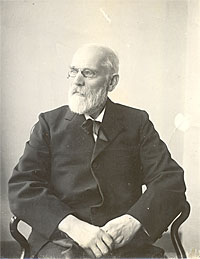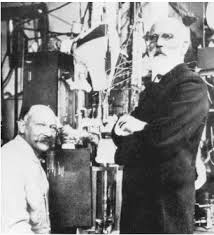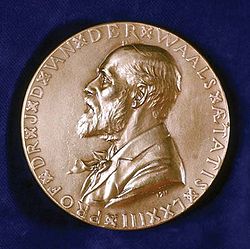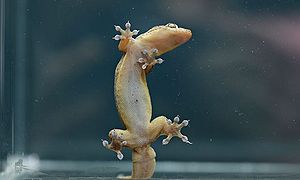Johannes Diderik van der Waals
written by Shania Oke
Johannes Diderik van der Waals was a Dutch theoretical physicist known for his work on thermodynamics. He is associated with the van der Waals equation, van der Waals forces between stable molecules, and van der Waals radii.

Biography
Early Years
Johannes Diderik van der Waals, the eldest of ten children, was born in Leiden, Netherlands on November 23, 1837. He was born to Jacobus van der Waals and Elisabeth van den Berg.
Education
Being a child of a 19th century working-class family, van der Waals did not have the opportunity to attend a secondary school that would have allowed him to enter any university. At fifteen years old, he finished his “advanced primary education” and then went on to become a teacher's apprentice in an elementary school. By 1861, he completed courses and received the qualifications to become a primary school teacher.
Even though he was not qualified to attend the University of Leiden due to his lack of early education in classical languages, van der Waals attended math, physics, and astronomy lectures in 1862. Fortunately, the University of Leiden implemented a program that allowed other students to take up to four courses a year.
The following year, the Dutch government started Hogere Burgerschools (HBS) which were secondary school education programs for children of higher middle class families. Still the head teacher of an elementary school, van der Waals made every effort to become a HBS teacher by spending the subsequent two years studying during his spare time in order to prepare for the required exams. Finally, in 1865, van der Waals was given a physics teacher position at a HBS in Deventer and then transferred to a HBS in The Hague a year later. Because of close proximity, this new position allowed him to continue his courses at the University of Leiden.
Later Years

Just before assuming his position at the HBS in Deventer, van der Waals married Anna Magdalena Smit. They had three daughters and one son who followed in his father’s footsteps.
The law regulating university entrance that prohibited van der Waals from pursing higher education was altered and the minister of education was given the power to exempt students from the study of classical language. Fortunately, van der Waals was given this privilege and passed the necessary math and physics qualification exams in order to pursue his doctorate. During his time at the University of Leiden, he studied the behavior of gases and demonstrated that the liquid and gas phases of a substance are of the same nature allowing the behavior and transition of said substance between states could be accurately predicted. His work was centered on the idea that molecules are of finite size and attract each other which was still a disputed scientific concept at the time.
At the age of 36, van der Waal defended his doctoral thesis (On the Continuity of the Liquid and Gaseous State) which covered the topic of substance continuity during gaseous and liquid states as well as new concepts of molecular volume and molecular attraction.
Van der Waals was selected to be the first professor of physics at the newly established Municipal University of Amsterdam in September of 1877, and had two very notable colleagues at this institution - Jacobus Henricus van’t Hoff and Hugo de Vries. Van der Waals worked at the Amsterdam University until he retired at 70. His son, Johannes Diderik van der Waals, Jr., who was also a theoretical physicist took his place at the University. In 1910, the 72-year-old van der Waals was awarded the Nobel Prize in physics for his research on gaseous and liquid states of matter and later died at the age of 85 on March 8, 1923.
Scientific Contribution
Van der Waals’ main focus was thermodynamics and was influenced by Rudolf Clausius' 1857 treatise (On the Kind of Motion which We Call Heat) and later by the writings of James Clerk Maxwell, Ludwig Boltzmann, and Willard Gibbs. Van der Waals’ 1873 dissertation (On the Continuity of the Liquid and Gaseous State) that outlined the idea of condensation and critical temperatures made waves in the field of physics and was widely recognized. In this same thesis, he derived what we now know as the van der Waals equation of state. His work on the topic allows us to understand how and why the liquid and the gas phases of a substance are able to continuously merge into each other due to their similarities.

In order to derive his equation of state, van der Waals had to assume that molecules existed (an idea disputed at the time), that they have a finite size, and that they display forces of attraction. Although elementary in nature, intermolecular forces were first proposed by van der Waals and are now occasionally referred to as van der Waals force.
In 1880, van der Waals formulated the Law of Corresponding States which demonstrated that the van der Waals equation of state can be applied to any substance using a simple equation that relates the pressure, volume, and temperature of said substance. This law was used by other scientists in many experiments-some of which led to the liquefaction of hydrogen and helium.
Ten years later, van der Waals published Theory of Binary Solutions in which he related his equation of state to the Second Law of Thermodynamics. He referenced the form of the Second Law proposed by J. Willard Gibbs and was able to produce a graphical depiction of his equation of state using Ψ. This idea was previously used by Gibbs to represent the most amount of work needed to return a thermodynamic system to equilibrium (Gibbs free energy).
In 1893, van der Waals added to the theory of capillary action from a basic thermodynamic perspective. Since the idea of molecules and what is now known as Brownian motion were still not universally accepted, van der Waals’ take on capillarity was a somewhat controversial topic at that time.
Van der Waals Equation
The molar form of the van der Waals equation that accounts for behavior of gases and liquids is as follows:
- [math]\displaystyle{ \left(P + \frac{n^2 a}{V^2}\right)\left(V-nb\right) = nRT }[/math]
where
- [math]\displaystyle{ a = N_A^2a' }[/math] which is the measure of how strongly the molecules of the substance are attracted to one another,
- [math]\displaystyle{ b = N_A b' }[/math] which is the measure of the finite volume occupied by the molecules of the substance,
- [math]\displaystyle{ n = N / N_A }[/math] which is the number of moles of the substance,
- [math]\displaystyle{ R = N_A k }[/math] which is the universal gas constant,
- and [math]\displaystyle{ N_A = 6.0222\times10^{23} mol^- }[/math] which is Avagadro's constant.
The overall equation shows the relationship of four variables of a substance- the pressure of the substance ([math]\displaystyle{ P }[/math]), the total volume of the container that holds the substance ([math]\displaystyle{ V }[/math]), the amount of moles of a substance ([math]\displaystyle{ n }[/math]), and the temperature of the system as a whole ([math]\displaystyle{ T }[/math]).
Van der Waals Radius
Since van der Waals was the first to recognize that atoms were actually spheres as opposed to just points in space and the first to determine the consequences of their size through the van der Waals equation, the van der Waals radius, [math]\displaystyle{ r_w }[/math], was named after him. The van der Waals radius of an atom is the radius of its “sphere” in space and can be used to model the atom in order to determine physical consequences.

Van der Waals Force
Van der Waal forces describe both the attractive and repulsive forces between molecules that are neither covalently bonded nor present electrostatic interactions. These forces can be found between atoms, molecules, surfaces, and other intermolecular forces. These molecules bond together because of differing polarities rather than through covalent or ionic bonding.
Honors and Distinctions
In addition to winning the Nobel Prize in Physics in 1910, van der Waals received many different honors and distinctions. The University of Cambridge awarded him an honorary doctorate. He was an honorary member of three different societies - the Imperial Society of Naturalists of Moscow, the Royal Irish Academy, and the American Philosophical Society, a corresponding member of two academies - the Institut de France and the Royal Academy of Sciences of Berlin, an associate member of the Royal Academy of Sciences of Belgium, and a foreign member of three societies – the Chemical Society of London, the U.S. National Academy of Sciences, and Rome’s Accademia dei Lincei. In 1875, van der Waals became a member of the Royal Netherlands Academy of Sciences (Koninklijke Nederlandse Akademie van Wetenschappen) and assumed the role of secretary from 1896 to 1912.
Connectedness
Johannes Diderik van der Waals and more importantly, his equation, play a big role in the field of chemistry (my current major). Much of scientists' understanding of chemistry relies on the basis of thermodynamics-the topics which van der Waals focused on throughout most of his scientific career. Chemical thermodynamics focuses on the relationship between heat, work, physical changes of state, and chemical reactions within the parameters outlined by the Laws of Thermodynamics. Chemical thermodynamics can be applied both in a lab setting as well as from a mathematical viewpoint. The van der Waals equation helps us to understand chemical reactions through mathematical application and deepens our understanding of the spontaneity of chemical processes. The equation accounts for the behavior of real gases and liquids through the relationship between pressure, volume, moles, and temperature of a substance.
References
"Johannes Diederik van der Waals". Encyclopædia Britannica. Encyclopædia Britannica Online. Encyclopædia Britannica Inc., 2015. Web. 03 Dec. 2015
"Johannes Diderik Van Der Waals." NNDB, 2014. Web. 04 Dec. 2015. <http://www.nndb.com/people/509/000099212/.
"Johannes Diderik Van Der Waals." Wikipedia. Wikimedia Foundation, 17 July 2015. Web. 04 Dec. 2015
"Johannes Diderik van der Waals - Biographical". Nobelprize.org. Nobel Media AB 2014. Web. 4 Dec 2015
"Van der Waals equation." Wikipedia. Wikimedia Foundation, 28 November 2015. Web. 04 Dec. 2015 <https://en.wikipedia.org/wiki/Van_der_Waals_equation>
"Van der Waals force." Wikipedia. Wikimedia Foundation, 03 December 2015. Web. 04 Dec. 2015 <https://en.wikipedia.org/wiki/Van_der_Waals_force>
"Van der Waals radius." Wikipedia. Wikimedia Foundation, 26 November 2015. Web. 04 Dec. 2015 <https://en.wikipedia.org/wiki/Van_der_Waals_radius>